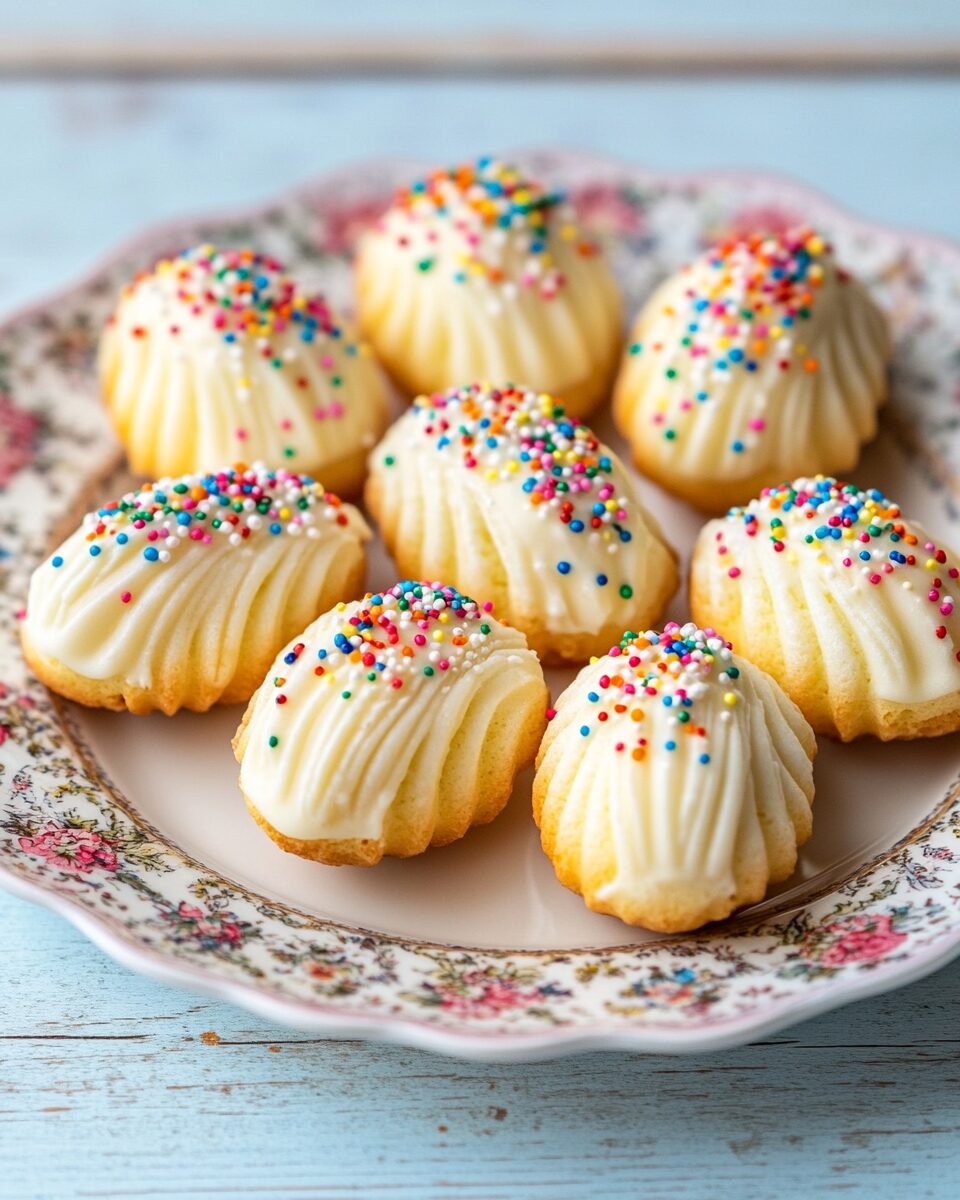These Easy Easter Madeleines are light, buttery, and perfectly sweet with a hint of vanilla and lemon zest. Their delicate shell shape makes them a charming addition to your Easter table. Perfect for tea time or as a festive dessert, these French-inspired treats are easy to make and even easier to enjoy!
Full Recipe:
Ingredients
- 1/2 cup (113g) unsalted butter, melted and cooled
- 2/3 cup (130g) granulated sugar
- 2 large eggs, at room temperature
- 1 teaspoon vanilla extract
- 1 teaspoon lemon zest (optional)
- 1 cup (125g) all-purpose flour
- 1 teaspoon baking powder
- 1/4 teaspoon salt
- 2 tablespoons milk
- Powdered sugar, for dusting (optional)
- Food coloring & sprinkles (optional, for decoration)
Directions
- Preheat oven to 375°F (190°C). Grease a madeleine pan with butter or nonstick spray.
- Whisk eggs and sugar in a mixing bowl until light and fluffy, about 3 minutes. Stir in vanilla extract and lemon zest.
- Sift together flour, baking powder, and salt, then gradually fold it into the egg mixture.
- Gently mix in melted butter and milk until just combined. Do not overmix.
- Cover the batter and refrigerate for at least 30 minutes (or up to 1 hour) to help create the signature hump.
- Spoon the batter into the madeleine molds, filling each about 3/4 full.
- Bake for 10–12 minutes or until the edges are golden brown and the tops spring back when lightly pressed.
- Cool in the pan for a few minutes, then transfer to a wire rack.
- Decorate as desired with a dusting of powdered sugar, pastel-colored icing, or sprinkles for an Easter touch.
- Serve and enjoy!
Nutrients (Per Madeleine, approx.)
- Calories: 110
- Carbohydrates: 14g
- Protein: 2g
- Fat: 5g
- Saturated Fat: 3g
- Cholesterol: 30mg
- Sodium: 40mg
- Sugar: 7g
These Easy Easter Madeleines are a delightful treat for the holiday, offering a soft, spongy texture with a lightly crisp edge. Perfect with a cup of tea or coffee! 🐣💛
The History of Madeleines
Madeleines have a long and rich history that dates back to the 18th century in France. Traditionally, they are small sponge cakes with a distinctive shell-like shape, achieved by using a special madeleine mold. It is believed that madeleines originated in the Lorraine region of France and were named after a pastry chef named Madeleine Paulmier. These delicate cakes quickly became popular and have remained a beloved treat in French baking for centuries. Over time, bakers have experimented with different flavors and variations, making them a versatile and customizable dessert. Easter Madeleines bring a festive twist to the classic recipe by incorporating pastel colors, sprinkles, and decorative elements to match the joyful spirit of the holiday.
Why Madeleines Are Perfect for Easter
Easter is synonymous with vibrant colors, sweet flavors, and elegant treats, making madeleines an ideal dessert for the occasion. Their delicate texture and subtly sweet flavor make them a favorite among both adults and children. Additionally, their charming appearance adds a sophisticated touch to any Easter gathering. These easy-to-make madeleines can be customized with food coloring, icing, and sprinkles to align with the festive Easter theme. Whether you serve them as part of an afternoon tea or a dessert platter, they are guaranteed to be a hit.
Tips for the Perfect Madeleines
Although madeleines are relatively simple to prepare, achieving the perfect texture and signature hump requires attention to detail. Here are some essential tips to ensure your Easter Madeleines turn out beautifully:
- Chill the Batter: One of the key secrets to achieving the classic madeleine hump is chilling the batter before baking. This allows the mixture to firm up, which helps create the characteristic dome when exposed to high heat.
- Use a Madeleine Pan: The unique shell shape of madeleines is achieved using a specific madeleine pan. Grease the pan well to ensure easy removal and a defined shell pattern.
- Do Not Overmix: Overmixing the batter can lead to dense madeleines rather than the light and airy texture they are known for. Gently fold the ingredients together until just combined.
- Watch the Baking Time: Madeleines bake quickly, usually within 10–12 minutes. Keep a close eye on them to prevent overbaking. They should be golden brown around the edges and slightly springy to the touch.
- Decorate for Easter: To enhance their festive appeal, dust madeleines with powdered sugar, drizzle them with pastel-colored icing, or add sprinkles. These decorative touches make them even more enticing for Easter celebrations.
Variations to Try
Madeleines are highly versatile, allowing for numerous flavor variations to suit different preferences. Here are some creative Easter-themed adaptations you can try:
- Chocolate-Dipped Madeleines: Dip one end of each madeleine in melted chocolate and add colorful sprinkles for an extra touch of sweetness.
- Coconut Madeleines: Add a touch of shredded coconut to the batter or sprinkle toasted coconut on top for a tropical twist.
- Almond Madeleines: Substitute vanilla extract with almond extract for a nutty and fragrant variation.
- Easter Bunny Madeleines: Use pastel-colored icing to decorate madeleines with bunny faces or Easter egg designs for a playful presentation.
- Citrus-Flavored Madeleines: Experiment with different citrus zest, such as orange or lime, to enhance the flavor profile.
Serving Suggestions
Easter Madeleines can be enjoyed in a variety of ways. Here are some serving ideas to make the most of these delightful treats:
- With Tea or Coffee: Madeleines pair beautifully with a warm cup of tea or coffee, making them an excellent choice for an Easter brunch or afternoon tea.
- On a Dessert Platter: Arrange madeleines alongside other Easter-themed desserts, such as cupcakes, cookies, and chocolates, to create an inviting dessert spread.
- Gift-Wrapped Treats: Packaged in decorative boxes or clear bags tied with ribbons, madeleines make thoughtful homemade gifts for friends and family during the Easter holiday.
- With Fresh Fruits: Serve madeleines with fresh berries, whipped cream, or fruit compote for an elegant and refreshing dessert.
- Dipped in Chocolate or Caramel: Enhance the flavor of madeleines by dipping them in melted chocolate or caramel sauce for a decadent treat.
Health Considerations
While madeleines are a delightful indulgence, they can also be adapted for dietary preferences:
- Gluten-Free Option: Substitute all-purpose flour with a gluten-free flour blend to make these treats suitable for those with gluten sensitivities.
- Dairy-Free Variation: Use dairy-free butter alternatives and milk substitutes such as almond milk or oat milk.
- Reduced Sugar Version: Reduce the sugar content or use natural sweeteners like honey or maple syrup for a less sweet variation.
- Egg-Free Alternative: Replace eggs with applesauce or mashed bananas for an egg-free version while maintaining the moist texture.
Conclusion
Easy Easter Madeleines are a perfect addition to any Easter celebration, combining elegance with delightful flavors. Their light, buttery texture and subtle hints of vanilla and lemon zest make them a crowd-pleasing dessert. Whether you choose to decorate them with pastel icing, dust them with powdered sugar, or enjoy them plain, madeleines offer a delightful treat that embodies the festive spirit of Easter. By following a few simple tips, experimenting with flavors, and presenting them creatively, you can elevate your Easter dessert table with these classic French treats. Enjoy making and sharing these wonderful madeleines with your loved ones this Easter season!






